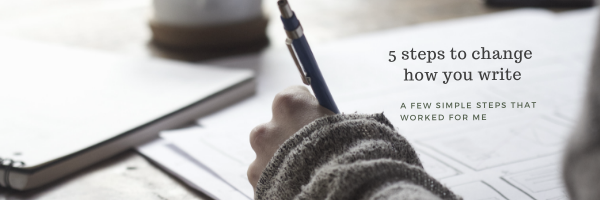For years I believed I could only write one way. I believed my brain worked better between certain hours, using one specific writing program and that it took me a certain length to write a book.
Sound familiar?
6 months ago my writing scheduled changed due to life. I didn’t have the time anymore to sit in front of a computer screen and wait for the words to come. I knew that if I wanted to maintain my writing schedule, I had to be open to change…and that meant changing how I write.
I love notebooks and have shelves full of them. I use a notebook every day to keep track of my life – and have one where I jot down book/plot ideas. I took this notebook with me to work on day and decided to change plotting on a computer to plotting in my notebook.

First I would keep track of characters – names, descriptions, emotional ARCS. Then the setting. Next came plot points – I would write down 30-40 things that I wanted to happen in the story. I would then organize these plot points into scenes. Normally, this is where I would stop using the notebook. When I first started writing, I was more panster than plotter. But the more books I wrote, the more contracts I signed, the more I had to become a plotter.
In the past, after figuring out my scenes, I would open Scrivener, create my notecards and start typing in scenes. But I couldn’t do that anymore…and I trained myself not to be able to write in Word (or Pages) so now what?
I trained my brain on how ‘not’ to write.
Creating new routines is hard, especially when it comes to re-training yourself how to write. I decided to start with the plot points I’d created and expand on them. I wrote each scene down, the things I wanted to have happen – the action, the tone of the dialogue and the emotional arc. I did this scene by scene, page by page until I hit the end. I then opened up the scrivener app on my phone and transcribed everything I’d written in my notebook (which turned out to be easier than I’d thought). I then compiled all of that into a word document which I could open on my computer…and voila…half the book is already written.
Using this method – I was able to write 2 full length novels and plot out a third – all within a 6 month window. This surprised me. Normally it takes me 6 months to write a book from start to finish.
As writers, we get stuck in a rut sometimes…we believe we can only write a certain way – we are creatures of habit. Some only write longhand. Some use dictation. Others are pansters while others are plotters and some are those who find themselves in between the two. There’s no right or wrong way when it comes how how you write. I’m not telling you that you should or even need to write a certain way…because there is no ONE WAY to write a book. But don’t be like me…believing I could only write ONE way (in Scrivener, when there’s no noise, between 8-12pm). I had to retrain my brain to write a different way and right now, this way is working for me. Maybe it will for you too…
5 TIPS TO CHANGING HOW YOU WRITE
(or RETRAIN YOUR BRAIN)
- Change your routine. If you think you can only write at home, when it’s quiet…drag yourself to a coffee shop and give yourself a word count before you can leave.
- Grab a notebook. Reaching for a pen and writing longhand forces our minds to use muscles we don’t use when typing.
- Turn off your internal editor. Stop editing as you write. Let the words flow. Magic happens during the revision process…honest.
- Let go of the word count. If, like me, you give yourself a minimum amount of words that you need to write…let it go. Give yourself permission to stop counting words. It’s easier when you’re writing long hand and don’t have the word count on the bottom of your screen.
- List 40 things to happen in your novel. Not only will this help you when it comes to pacing but you’ll be able to see holes in your plot faster.
I hope this helps…let me know if it does!





Love this. Thank you for sharing.
Welcome!!!
Great ideas here, Steena! I’ve been trying some new things that are similar to what you suggested here and have noticed a huge difference. I’ll try some of your ideas, too! I’m always looking for ways to be more productive. Cheers!
Oh…what things are you trying? It took me years to get out of my head but I’m so glad I did!
Earlier this year, I read “2,000 to 10,000” by Rachel Aaron and started doing two things that immediately increased my word count: tracking my time writing and word count like a fanatic using a spreadsheet (which helped me stay focused and be more productive while writing and to be able to track my improvement over time) and also taking five minutes to use a pen and paper to jot down an entire scene’s action before starting to type, which takes all the pressure off and lets you make decisions in a lower-pressure situation.
After starting that second one, I hit my highest daily word count for fiction ever at 6,560 in less than 6.5 hours. That’s also my highest word count/hour for fiction writing. (These were both about 30% higher than my previous records. I think. I wasn’t tracking before, so that’s kind of a mental milestone percentage increase!) I do have goal word counts, but having those helps me release my inner editor while drafting instead of freaking me out. If my goal is just to get the words on a page without revising as I go, then the word count helps me know if I am accomplishing that in the amount of time I have to write in a day, since revise-and-type slows me down.
I’m currently plotting out my next two novels (the second and third of a trilogy) and I’m doing kind of what you’re doing by starting out with bullet points of what I want to have happen, then really fleshing them out right in the cards in Scrivener. I plan to do the hand-written scene outline before writing when I start writing in earnest. This is the most I’ve ever pre-plotted a story, and I’ve tried to stop being frustrated that I’m not actually “writing” and to start looking at it as the zero draft. I am writing, but they won’t be the final words. Which means the drafting will go faster and I’ll have less to cut. (It took me a year to draft the first book. I think I’ll manage book 2 in less than 3 months.)
One more thing that was interesting when I adopted that new technique: Previously, I always planned on increasing my word count by about 30% during revisions. For the section of my story where I tried the new technique, it only went up about 10%, because the first draft was so much cleaner and I was able to express myself much more clearly the first time.
I never expected that writing something long hand for a few minutes would have such a dramatic impact, but it did. Rachel has some other awesome plotting and productivity tips in the book, too. I recommend it. But it sounds like you don’t need it anymore, so that recommendation is for others who are struggling with their productivity like I was!
I love that there’s no right or wrong way..any way that helps you to be more productive and write stronger books is all that matters!
Absolutely. And everyone is different! 🙂